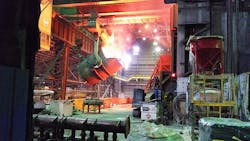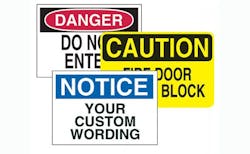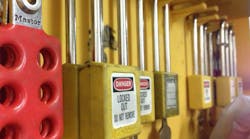No leader wants employees to get injured at work, but sadly and quite often, the cost of safety (e.g., additional time and capital spent for material and equipment) gets in the way of making good decisions. When the cost of safety becomes a burden to the organization, the safety approach begins to suffer.
Wouldn’t it be nice if there were a way to reduce this “cost,” add more value and achieve the level of safety required? Well, there is a way…the answer is by making your safety approach more efficient.
Recently a company that we work with asked us to assess the effectiveness of its safety approach. To gather the data, we traveled to many of its sites around the world and interviewed about 800 employees and 100 first-line supervisors. One of our supervisor questions was, “How much time do you spend on safety?” Most of the supervisors interviewed agreed that they spent at least 60% of their day on safety-specific activities such as safety observations, incident investigations, training, completing forms, making presentations and data entry.
When we presented this information to the management team, the safety professionals were happy while the operations folks were not as pleased. If your company is in the business of making things or providing a service, then spending 60% of your time doing something else is not going please your operations management, customers or investors.
Having lived in both the safety and operations leadership worlds, I understand both perspectives. The solution, of course, lies somewhere in the middle. That middle ground is achieved through a common understanding of how to be both effective and efficient at safety.
Here are some practices to improve the effectiveness and efficiency of your safety approach:
1. Integrate safety into operational and support processes.
fatality prevent standards and controls, perception of fatality risk, unreported fatality situations.
Photo: OpX Safety
If safety is “bolted on” to your organization and the way you operate, realize that everyone has a wrench. To foster integration, operational leaders may need to help their safety professionals become more operationally savvy. Specific examples of safety integration can include:
- Include the hazardous energy control (lockout/tagout) process in the work order and/or work instruction. This creates a more efficient and integrated work process where maintenance staff are less likely to forget the requisite safety measures. Therefore, doing the job well means doing the job safely.
- How many of your folks hate to conduct a job hazard/safety analysis (JHA or JSA)? Part of the reason is that it’s perceived as “extra.” Perceptions of extra work, time, paperwork, etc., contribute to poor decision-making. Integrating the JHA expectations into operational standard work will make safety and the work process more effective and efficient. For example, the first of the three elements in a JHA is the task list. This should be part of the work instruction, job plan or defined in a pre-job meeting. Having to determine how the work will be performed by requiring the completion of a JHA is evidence that the overall job planning process is weak.
- Whenever possible integrate safety training into work process training. For example, if your organization conducts job/task-specific training (and refresher training), then include the required Hazard Communication elements in that training rather than making everyone attend a “generic” hazard communication training session. The hazard communication elements such as job-specific chemical hazards and protective measures will be more germane and seen as part of the task, and the knowledge will be transferred in a more sustainable and cost effective manner.
2. Make “safe” more apparent and visual.
Though it may require a safety professional to determine how to make the process safe (e.g., compliant with requirements, low risk), it shouldn’t take a safety professional to keep it safe. If you make correct safety (e.g., expected workplace conditions, body positions and activities) visually apparent, then it will be easy for anyone to identify non-conformities. When you make correct safety visually apparent, everyone becomes a safety leader. Here are the steps:
- Define the right way (condition, body position, etc.). For example, what should the pressure gauge read when the process is healthy?
- Recruit those in your organization with process knowledge and creative energy (See No. 3 below) to design the visual cues.
- Create visual cues that make it easy (for anyone) to see what right looks like. Provide examples such as color coding and photos/diagrams of the right condition, position, etc. Remember, the goal is that anyone walking by can determine if it’s right or wrong.
- Use people with no process and technical knowledge to check your work.
Check out dozens of safety signage and warning device options on NED's Directory side.
3. Make the process the shortcut. Use your expert “hackers” to design the process.
It is human nature to shortcut. We’ve all on occasion cut diagonally across the grass instead of following the longer route defined by the sidewalk. When safety measures become impediments to production or are perceived as extra and employees decide to omit a step or create a work-around, the results can be tragic. Short-cutting, such as skipping safety steps or using the wrong tool for the job is often found in the chain of causes for injuries and fatalities.
If you have discovered “custom” job aids in your workplace (e.g., tools made by employees and markings on operational controls) it’s an indication that short-cutting is present. When these shortcuts are discovered, it’s imperative that operational leaders ensure that the root reasons are identified and included the process design and redesign initiatives.
To get ahead of floor-level process hacking, have the hackers help design the process. That’s right, make the process the shortcut, by design. One of the principles that I learned early in my leadership career is that you can’t put energy into people. Unfortunately, for various reasons, some of the most energetic and purposeful people will be found working against the system. Law enforcement agencies have been able to find value in savvy lawbreakers for years, taking the best computer hackers and putting them to work in cyber security and investigations.
To move people from the “dark side,” start by acknowledging their energy, capacity, savvy and ingenuity. Include these folks in process design/re-design teams and give them a stake in making the process the shortcut and shortcut-proof.
Provide the team with your organization’s quality, operational excellence, safety, etc., performance expectations and challenge them to make the process both safer and more effective/efficient. Validate the new approach with inexperienced employees during the most challenging operational periods. For example, if safety seems to take a back seat at the end of the month when your product gets shipped, this is a good time to test the shortcut-proofing of the process.
To give one of these principles a try in your organization, create a small working team, provide guidance and support, build consensus on a pilot project (a simple one), generate some success and momentum, and then stand back.
This article originally appeared in IndustryWeek.

















